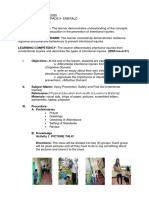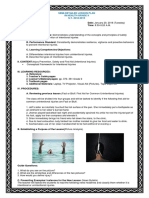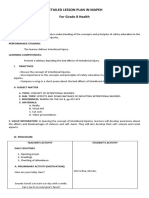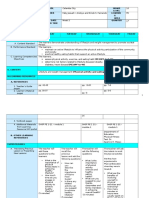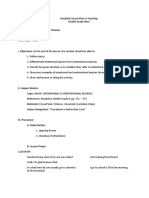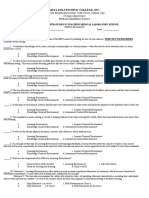Fourth Demonstration Teaching in Health 9: Grade&Section: Petsa: Time: Schedule: A. Content Standard
Fourth Demonstration Teaching in Health 9: Grade&Section: Petsa: Time: Schedule: A. Content Standard
Uploaded by
ivan hernandezCopyright:
Available Formats
Fourth Demonstration Teaching in Health 9: Grade&Section: Petsa: Time: Schedule: A. Content Standard
Fourth Demonstration Teaching in Health 9: Grade&Section: Petsa: Time: Schedule: A. Content Standard
Uploaded by
ivan hernandezOriginal Title
Copyright
Available Formats
Share this document
Did you find this document useful?
Is this content inappropriate?
Copyright:
Available Formats
Fourth Demonstration Teaching in Health 9: Grade&Section: Petsa: Time: Schedule: A. Content Standard
Fourth Demonstration Teaching in Health 9: Grade&Section: Petsa: Time: Schedule: A. Content Standard
Uploaded by
ivan hernandezCopyright:
Available Formats
FOURTH DEMONSTRATION TEACHING IN HEALTH 9
Grade&Section: 10-Matapat Petsa: March 2, 2020
Time: 7:30-8:30 Schedule: TWTHF Monday
I. OBJECTIVES
A. Content Standard The learner demonstrates understanding of the concepts and
principles of safety education in the prevention of intentional
injuries.
B. Performance Standard The learner consistently demonstrates resilience, vigilance and
proactive behaviors to prevent intentional injuries.
C. Learning 1. describes the types of intentional injuries-H9IS-IVa-d-32
Competency/Objectives 2. analyzes the risk factors related to intentional injuries-H9IS-IVe-h-33
3. identifies protective factors related to intentional injuriesH9IS-IVe-h-34
II. CONTENT Lesson/Topic: HEALTH CAREER PLANNING
III. LEARNING RESOURCES Chalk at chalkboard, laptop, power point, printed materials
1. References Physical Education and Health, Horizons LM pages 305-307
2. Other Learning Resource K12 Basic Education Curriculum Guide for MAPEH Grades 1-10
IV. PROCEDURES a. Greetings
b. Prayer
c. Checking of Attendance
A. Reviewing previous lesson or Presentation of Intentional Injuries to the students.
presenting the new lesson The students lead to the topic to be discussed by means of the
motivational activity.
B. Establishing a purpose for the At the end of the lesson, the students will be able to;
lesson 1. Describe the types of intentional injuries.
2. Analyze risk factors related to intentional injuries.
3. Identify protective factors related to intentional injuries.
C. Presenting examples/Instances of Activity 1. Through different perspectives.
the new lesson The students will complete the sentences for each character and share
their responses with the class.
How do other people view the concept of injury?
D. Discussing new concepts and Activity 2. Intentional Injuries: Types and Characteristics
practicing new skills#1 The students will read the topics assigned to their group and answer the
guide questions given by other students after.
What is the meaning/definition?
What is its category/classification/types?
How will you recognize this kind of injury? What are the
indicators?
What are the effects on the victims?
How it could be prevented?
E. Discussing new concepts and Activity 3. Creative Presentations
practicing new skills#2 The students will present to the class their answers based on what they
have just read. It could be dramatization, poetry/jingle, collage or picture
series.
(integration of ESP in discussing the prevention of these injuries.)
(There are corresponding claps for each presentation of groups.)
F. Developing mastery (leads to Activity 4. News Bulletin.
Formative Assessment 3) The students will read the headlines then classify them in which type of
intentional injuries they belong.
How can you classify this headline?
G. Finding practical application of Activity 5. Newspaper clips.
concepts and skills in daily living The students will answer the guide questions as to what the news was
all about.
(Integration of History based on the national-related news about the
cases of intentional injuries.)
What type of intentional injuries are being portrayed in the
illustrations?
Based on the illustrations, what are the effects of intentional
injuries on their victims.
What are the other impacts of intentional injuries?
H. Making generalizations and What are the types of intentional injuries?
abstractions about the lesson How can we prevent those intentional injuries?
I. Evaluating learning The students will answer the true or false type of examination.
J. Additional activities for Have a list of scenes that shows violent actions and behaviors leading to
application or remediation intentional injuries from a TV show that you have recently watched.
V. REMARKS
VI. REFLECTION
A. No. of learners who earned 80% in the
evaluation
B. No. of learners who require additional activities
for remediation who scored below 80%
C. Did the remedial lessons work? No. of learners
who have caught up with the lessons
D. No. of learners who continue to require
remediation
E. Which of my teaching strategies worked well?
Why did this work?
F. What difficulties did I encounter which my
principal or supervisor can help me solve?
G. What innovation or localized materials did I
use/ discover which I wish to share with other
teachers?
You might also like
- Assessment Item 2Document32 pagesAssessment Item 2api-324846334100% (1)
- Suggestopedia MethodDocument13 pagesSuggestopedia MethodAfiqah Zainal100% (4)
- Detailed Lesson Plan: Region X-Northern Mindanao City of OzamizDocument4 pagesDetailed Lesson Plan: Region X-Northern Mindanao City of OzamizRo Jill Palacio Oling100% (3)
- Mapeh 9 P.E. Q4Document17 pagesMapeh 9 P.E. Q4sheryl guzmanNo ratings yet
- Injury Prevention, Safety and First AidDocument12 pagesInjury Prevention, Safety and First Aidjohann reyes0% (2)
- Semi - Detailed Lesson Plan For C.O. (4TH Quarter)Document4 pagesSemi - Detailed Lesson Plan For C.O. (4TH Quarter)May Ann C. Payot100% (3)
- Semi-Detailed Lesson Plan in Health Grade 9 S.Y. 2018-2019Document2 pagesSemi-Detailed Lesson Plan in Health Grade 9 S.Y. 2018-2019Selle Sanchez100% (2)
- Lesson PlanDocument3 pagesLesson Plansung_kei_pin88% (17)
- H9IS IVa D 32.Document4 pagesH9IS IVa D 32.Mellissa Suderio100% (1)
- Semi-Detailed Lesson Plan in P.E. 10: Hip-Hop DanceDocument3 pagesSemi-Detailed Lesson Plan in P.E. 10: Hip-Hop DanceSky Gaudia100% (1)
- Step Standard 7Document2 pagesStep Standard 7api-522550593No ratings yet
- Q4 Cot Mapeh 7-Non Communicable DiseasesDocument3 pagesQ4 Cot Mapeh 7-Non Communicable DiseasesGARRY REYES100% (1)
- q4 Cot Health 9 Intentional InjuriesDocument4 pagesq4 Cot Health 9 Intentional InjuriesARIEL RODRIGO U. TAMAYAO0% (1)
- Health 9 - Lesson PlanDocument5 pagesHealth 9 - Lesson PlanFarah Myieknzy Romero - ArdozaNo ratings yet
- Intentional and inDocument5 pagesIntentional and inMhae MataNo ratings yet
- Intentional Injury Final DemoDocument4 pagesIntentional Injury Final DemoKristela Mae Coloma50% (2)
- SuicideDocument4 pagesSuicideAngelica Pataray ErjasNo ratings yet
- Health G9 FOURTH GRADINGDocument3 pagesHealth G9 FOURTH GRADINGVenusNo ratings yet
- Intentional and UnintentionalDocument6 pagesIntentional and UnintentionalCatherine Liesha De ChavezNo ratings yet
- Health9q4 PDFDocument35 pagesHealth9q4 PDFRUEL PURISIMANo ratings yet
- DLP in-Health-Grade-9 Types of Intentional InjuryDocument10 pagesDLP in-Health-Grade-9 Types of Intentional InjuryMarvin Marano100% (2)
- 4TH Quarter - 9 HealthDocument6 pages4TH Quarter - 9 HealthLynn Roa Dagsa - Miniao100% (1)
- Quarter 2 Lesson Plan in Mapeh 9 (Health)Document16 pagesQuarter 2 Lesson Plan in Mapeh 9 (Health)Katrine Kae G. PradoNo ratings yet
- Lesson in Mapeh 9Document3 pagesLesson in Mapeh 9CJ TanNo ratings yet
- Detailed Lesson Plan in Mapeh For Grade 8 HealthDocument6 pagesDetailed Lesson Plan in Mapeh For Grade 8 HealthJoe Levinne100% (2)
- Social Dance Lesson PlanDocument3 pagesSocial Dance Lesson PlanMichelle G. LogronioNo ratings yet
- HEALTH - Q3 PPT-MAPEH9 - Lesson 2 (Assessing Emergency Situations)Document19 pagesHEALTH - Q3 PPT-MAPEH9 - Lesson 2 (Assessing Emergency Situations)Rou Ann Navarroza100% (5)
- Lesson Plan in Grade 9 PE 4th QuarterDocument4 pagesLesson Plan in Grade 9 PE 4th QuarterDenbigh Cinco100% (2)
- Final Demo Lesson PlanDocument9 pagesFinal Demo Lesson PlanAngelica Pataray Erjas100% (1)
- Dlp-Cot-Q3-Festival Dancing-1Document5 pagesDlp-Cot-Q3-Festival Dancing-1Joseph Sadia100% (1)
- FESTIVAL IN THE PHILIPPINES (PE9RD-IIb-1)Document9 pagesFESTIVAL IN THE PHILIPPINES (PE9RD-IIb-1)Judy Ann MorilloNo ratings yet
- Cot 1 DLP Health-9Document7 pagesCot 1 DLP Health-9Jessieann Balmaceda CabanganNo ratings yet
- Detailed Lesson Plan in MAPEH 9Document4 pagesDetailed Lesson Plan in MAPEH 9Frances Joyce ConcolesNo ratings yet
- COT 3rd Quarter DLL PEDocument4 pagesCOT 3rd Quarter DLL PEOliver Narciso100% (2)
- Mapeh 10Document9 pagesMapeh 10ROSELYN LABADANNo ratings yet
- DLL Week 1Document11 pagesDLL Week 1frank vergNo ratings yet
- Zumba (Final Demo)Document10 pagesZumba (Final Demo)Hyzel Faith ParanNo ratings yet
- Dlp-Cot-Q4-Zumba Fitness DanceDocument8 pagesDlp-Cot-Q4-Zumba Fitness DanceJoseph SadiaNo ratings yet
- 2ND QUARTER-HEALTH-Lesson PlanDocument24 pages2ND QUARTER-HEALTH-Lesson PlanEthel Marie Casido BurceNo ratings yet
- I. Objectives: Detailed Lesson Plan in Grade 9 HealthDocument6 pagesI. Objectives: Detailed Lesson Plan in Grade 9 HealthIan AtienzaNo ratings yet
- Detailed Lesson Plan in Health Final DemoDocument4 pagesDetailed Lesson Plan in Health Final DemoSheryl Abuel-Rojas100% (1)
- Detailed Lesson PlanDocument2 pagesDetailed Lesson PlanMa. IvoryVan SantillanNo ratings yet
- Learning Activity Sheet in Health Grade 9: An Essential Element of Standard Wound CareDocument8 pagesLearning Activity Sheet in Health Grade 9: An Essential Element of Standard Wound CareBaby OREONo ratings yet
- Lessonplan MAPEH 10Document2 pagesLessonplan MAPEH 10novelle palacioNo ratings yet
- Queen DLP CSE Demo Intentional InjuriesDocument9 pagesQueen DLP CSE Demo Intentional InjuriesRhylyahnaraRhon Palla Peralta100% (2)
- Final DemoDocument6 pagesFinal DemoLilian Rose de LaraNo ratings yet
- Lesson Plan in Grade 9 Music: Mrs. Rosemarie Ann C. Camacho Teacher IDocument4 pagesLesson Plan in Grade 9 Music: Mrs. Rosemarie Ann C. Camacho Teacher Irose catamoraNo ratings yet
- DLL - G9.PE.Q4. Week2Document7 pagesDLL - G9.PE.Q4. Week2Aika Padagas Abalos Cayaban100% (1)
- Detailed Lesson Plan in HealthDocument7 pagesDetailed Lesson Plan in HealthAnneyy mnrlNo ratings yet
- DLP Indoor and Outdoor Activities Grade 9 P.EDocument7 pagesDLP Indoor and Outdoor Activities Grade 9 P.EGina Dela RosaNo ratings yet
- My Final DemoDocument10 pagesMy Final DemoJeremy Desoyo Torres0% (1)
- New Lesson Plan 1Document3 pagesNew Lesson Plan 1RhyngelNo ratings yet
- Lesson Plan-Q3 h9Document3 pagesLesson Plan-Q3 h9LOURD GINA JUANICONo ratings yet
- DLP COT DrugsDocument2 pagesDLP COT DrugsJelly Mae Getalla100% (1)
- Planning For Health Career 4as Lesson PlanDocument5 pagesPlanning For Health Career 4as Lesson PlanJeraldine Mendoza100% (1)
- 4THQ Cot (Pe)Document3 pages4THQ Cot (Pe)AJ ReclosadoNo ratings yet
- DLP 4th Quarter Health 9-InjuriesDocument13 pagesDLP 4th Quarter Health 9-InjuriesAda Ricana100% (1)
- Detailed Lesson Plan On Mapeh 8Document7 pagesDetailed Lesson Plan On Mapeh 8JamesNo ratings yet
- Detailed Lesson Plan in Teaching - Health 9 For DEMODocument4 pagesDetailed Lesson Plan in Teaching - Health 9 For DEMOHazel Anne Alcala CompocNo ratings yet
- Lesson For DemoDocument6 pagesLesson For DemoDebby BantugNo ratings yet
- Additional Materials From Learning ResourcesDocument2 pagesAdditional Materials From Learning ResourcesMardezz AcordaNo ratings yet
- Proceed To Explain Today's Lesson (Intentional Injuries) : Injury Prevention, Safety and First Aid (Intentional Injuries)Document5 pagesProceed To Explain Today's Lesson (Intentional Injuries) : Injury Prevention, Safety and First Aid (Intentional Injuries)shirlykaecNo ratings yet
- Lesson Plan in MapehDocument3 pagesLesson Plan in MapehGladez Galagaran100% (1)
- Demonstration Teaching in Health 10Document2 pagesDemonstration Teaching in Health 10ivan hernandez100% (3)
- Daily Lesson Plan in Physical Education Part 2Document1 pageDaily Lesson Plan in Physical Education Part 2ivan hernandez0% (2)
- Physical Activity and Active RecreationDocument38 pagesPhysical Activity and Active Recreationivan hernandezNo ratings yet
- Tarpapel Family 5 IntramuralsDocument9 pagesTarpapel Family 5 Intramuralsivan hernandezNo ratings yet
- Arrangement of Contents of ProjectDocument3 pagesArrangement of Contents of ProjectRithesh RajNo ratings yet
- Poisoned Talk Poem Causes EffectsDocument2 pagesPoisoned Talk Poem Causes EffectsAlia AmirahNo ratings yet
- Morris Jamie - Paper Guided ReadingDocument20 pagesMorris Jamie - Paper Guided ReadingSwati RaiNo ratings yet
- Uwi Open Campus Edtk Assignment 2Document5 pagesUwi Open Campus Edtk Assignment 2api-302261930No ratings yet
- Student Teaching Experience at Risen Christ Catholic School Silang, CaviteDocument11 pagesStudent Teaching Experience at Risen Christ Catholic School Silang, CaviteTrina CanizoNo ratings yet
- My FS2Document45 pagesMy FS2joel blaya0% (1)
- Economic Systems Lesson PlanDocument4 pagesEconomic Systems Lesson Planapi-340380090No ratings yet
- Music Lesson PlanDocument3 pagesMusic Lesson Planapi-550859861No ratings yet
- Lesson Planning 2Document28 pagesLesson Planning 2AltheaGuanzonNo ratings yet
- Weekly Home Learnig Plan Grade 12 Introduction To The Philosophy of The Human PersonDocument2 pagesWeekly Home Learnig Plan Grade 12 Introduction To The Philosophy of The Human PersonAbygiel SalasNo ratings yet
- Teaching Young Language Learners, by Annamaria Pinter: Reading GuideDocument5 pagesTeaching Young Language Learners, by Annamaria Pinter: Reading GuideEFL TeacherNo ratings yet
- Tue - 5H - Eng - 11.10. 2022 - Speaking Test - SPM TrialDocument2 pagesTue - 5H - Eng - 11.10. 2022 - Speaking Test - SPM TrialJIHEK ANAK KIDEM KPM-GuruNo ratings yet
- Lac Module 1 and 2Document3 pagesLac Module 1 and 2John Philip HernandezNo ratings yet
- Grade 1 l9Document2 pagesGrade 1 l9api-364700795No ratings yet
- Weekly Accomplishment Report Template - Week 3Document3 pagesWeekly Accomplishment Report Template - Week 3Bolisa, Ericka D.No ratings yet
- Grade 7 BasketballcriterionbdDocument2 pagesGrade 7 Basketballcriterionbdapi-274815684No ratings yet
- Critical Factors in Reading Comprehension Instruction For Students Teaching PPT 1Document17 pagesCritical Factors in Reading Comprehension Instruction For Students Teaching PPT 1api-300874571100% (1)
- Program Activity Design: Division of Cebu ProvinceDocument2 pagesProgram Activity Design: Division of Cebu ProvinceCharie P. GraciaNo ratings yet
- North Borneo University College: Assessment Cover SheetDocument10 pagesNorth Borneo University College: Assessment Cover SheetAmeerah Lyeana AnaNo ratings yet
- Yuta Otake Resume - 1218Document2 pagesYuta Otake Resume - 1218Quetzalcoatl Apophis SerpentNo ratings yet
- EsP Blank 4th NO PTDocument20 pagesEsP Blank 4th NO PTRitchel San Mateo MendozaNo ratings yet
- MidtermExam MT PSTMLS-printDocument4 pagesMidtermExam MT PSTMLS-printIvy Jean FelicianoNo ratings yet
- School ReportDocument2 pagesSchool ReportVivian HipolitoNo ratings yet
- 10 Principles - Assessment For LearningDocument3 pages10 Principles - Assessment For LearningAndy Pierce67% (3)
- Lesson Multi 123Document7 pagesLesson Multi 123Maria Dhalia MarquezNo ratings yet
- Study Guide Finally 123Document36 pagesStudy Guide Finally 123Krizza Aubrey Orias AmparadoNo ratings yet
- Course Syllabus English 2Document5 pagesCourse Syllabus English 2Purwa NugrahaNo ratings yet





